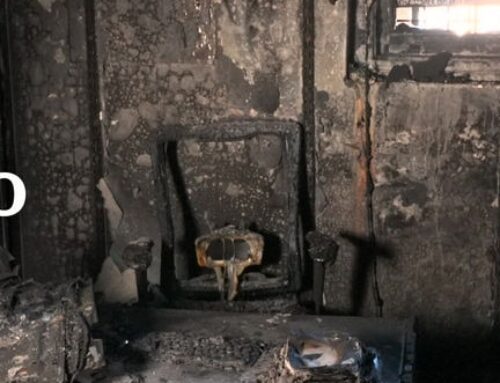When the COVID-19 pandemic hit, working from home became the new norm for many Australians as workplaces embraced flexible working arrangements.
But what happens if you are injured while doing so?
A recent employment tribunal ruling about a woman who tripped over a temporary puppy fence when she left her home office to make a coffee sheds light on the unique risks that come with remote working.
In this case, the woman was allowed to work from home for a day to care for a colleague’s puppy.
The tribunal found the woman’s injuries “arose out of her employment”, meaning she will be eligible for workers compensation — though the exact amount she’ll get has not yet been determined.
The case raises questions about who is responsible for a worker’s safety when they’re working remotely.
What was the tribunal ruling?
The judgment, handed down by the South Australian Employment Tribunal, was about the case of a City of Charles Sturt employee who tripped over a 60-centimetre metal pet fence she’d placed across the doorway to her sunroom, where her home office was set up.
The day was September 19, 2022, and the woman had put the fence in place to protect her pet rabbit from the puppy.
About an hour after she started work, the woman took a break intending to make a coffee.
As she walked toward her kitchen, she tripped over the pet fence breaking her arm and injuring her knee.
She was taken to hospital via ambulance.
What did the tribunal consider?
In the ruling, the tribunal deputy president, Magistrate Jodie Carrel, considered the Return to Work Act 2014 (SA), which governs the scheme that supports workers who suffer injuries at work in SA.
She found the woman’s home was “her place of employment within the meaning provided” in the act.
Magistrate Carrel also noted that while the woman had created the risk in her home, that did not exclude her injuries from being work-related.
The council worker was allowed to work from home for the day. (ABC News: Guido Salazar)
She noted that “the fact [the worker] created the workplace hazard the day prior, and unbeknown to the council, does not preclude a finding that it is an employment-related cause”.
Magistrate Carrel ruled the woman’s injuries “arose out of her employment” and that “the physical workplace hazard, being the pet fence” was a “significant contributing cause of her injuries”.
She also found the woman was “taking an authorised paid coffee break” when she tripped.
“Unsurprisingly, this practice was permitted by the council and was consistent with its encouragement for employees to take regular short breaks away from their workstations,” the judgment noted.
“Taking a coffee break is a likely act of an employee during the course of their working day.”
What is workers compensation and who can claim it?
Workers compensation is a form of insurance payment for employees who are injured, or become ill, due to their work.
This includes payments like wages to cover when a worker isn’t at work, and for medical expenses and rehabilitation.
Employers in each state around Australia must take out workers compensation insurance to cover themselves and their staff.
Legislation governing workers compensation around Australia is state specific. Each state has a workers compensation regulator.
In SA, the Return to Work Act 2014 (SA), an injury is considered to have arisen from work if it happens during the course of employment and that employment was a significant cause of the injury.
This includes when working from home or remotely — such as being on an authorised break.
What are the implications of the judgment?
Since the COVID-19 pandemic, more Australians are working from home and it’s easy to see why — there’s less time spent travelling to work, more flexibility and a better work-life balance.
But it’s not just employees who can benefit.
SA Business Chamber chief executive Andrew Kay said there were also positives for employers.
“The employer can benefit through greater employee satisfaction and therefore staff retention and hopefully increased efficiency and productivity,” he said.
But, as the tribunal highlights: “Those benefits are accompanied by additional risks.”
“A private residence of a worker may have unique risks not usually found in the employer’s workplace,” the judgment states.
The council employee was taking a coffee break when she tripped. (Supplied: Melinda Bannister)
Mr Kay said employers faced the challenge of ensuring their staff were safe at work and outside of the traditional office setting.
He said the tribunal’s decision “underscores the need for employers to reassess their remote work policies” to consider “the specific risks present in employees’ homes”.
“Businesses will need to be very vigilant in understanding remote working arrangements they have in place and implement policies around these to protect both the employee and the business,” he said.
How should home offices be set up?
Mr Kay said every working from home arrangement was “not a one size fits all”.
“Employers have a primary duty of care to ensure the health and safety of their employees, which extends to the home when working from home arrangements are in place and of course both physical and psychological health,” he said.
He urged employers to make sure employees’ home office areas were free of risks “as far as reasonably practicable”.
The council employee was working from home when she tripped over a metal pet fence.
He said employers should also have working from home policies and procedures in place.
“Employers should also have a working from home checklist, which is a good starting point to help identify common hazards which may be present when working from home,” he said.
“It’s also important to recognise that workers have WHS (work health and safety) responsibilities when working from home and that WHS risks must still be managed.”
According to documents available online from Safe Work Australia, while employers have a duty of care to their workers, employees must also take reasonable care for their own health and safety.
They must also comply with reasonable work health and safety instructions and cooperate with their employers’ policies or procedures.




